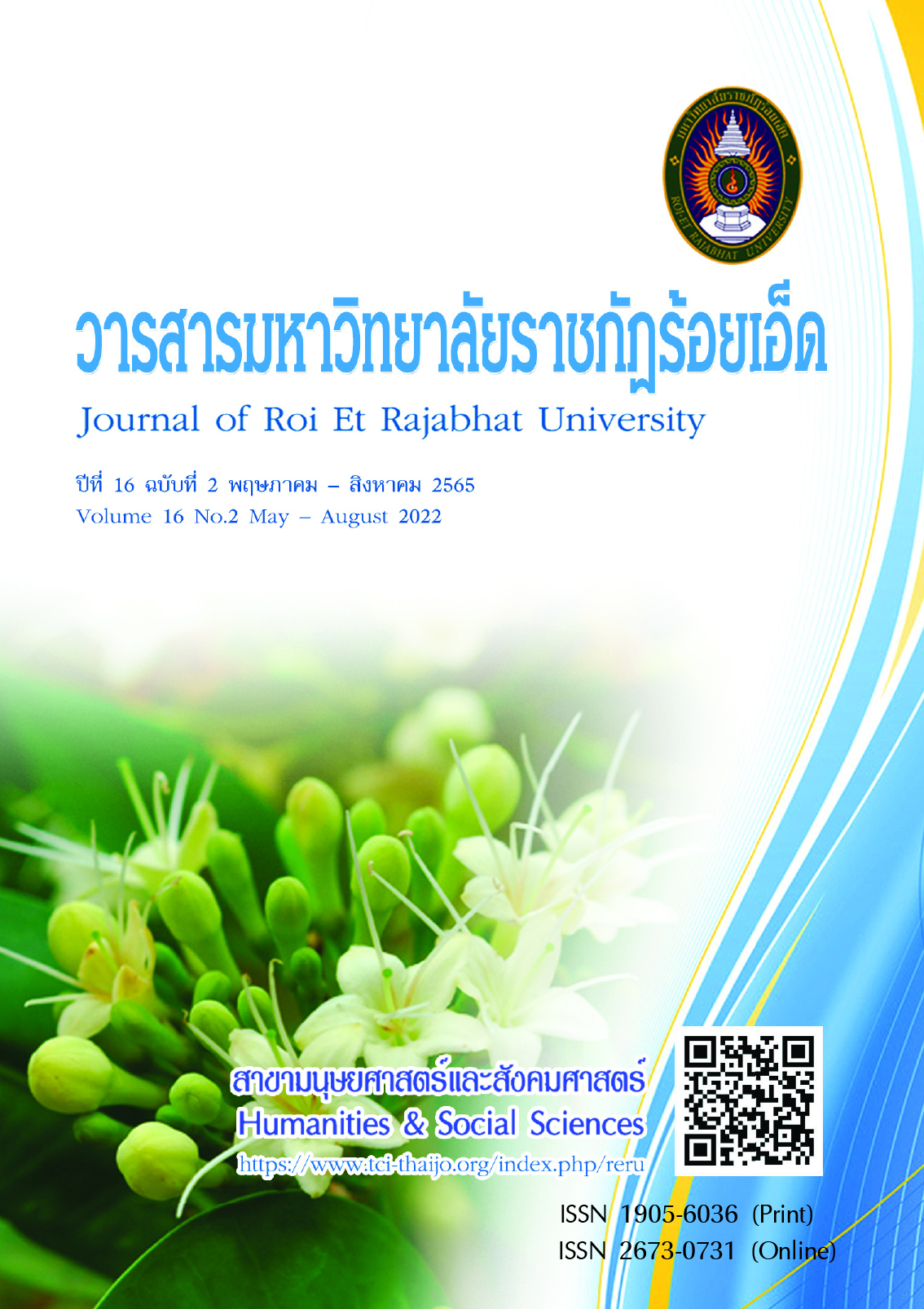The Development of Mathematical–Solving and Analytical Thinking Abilities Using Constructivist Theory with Think-Talk-Write Technique for Grade 9 Students
Keywords:
Constructivist theory with Think-Talk-Write technique, Mathematical problem-solving ability, Critical thinkingAbstract
This research aimed to 1) develop grade 9 students’ mathematical problem-solving and analytical thinking abilities using constructivist theory with Think-Talk-Write technique so that the students’ average score of mathematical problem-solving and critical thinking were not less than 80% and the number
of students who passed the criteria was not less than 80% of all students. The target group consisted
of 24 students studying in grade 9 (Matthayom 3/4) at Princess Chulabhorn Science High School Loei.
The research design was three cycles used in Action Research. The research instruments categorized into
3 categories were: 1) experimental tools, including 12 lesson plans using constructivist theory with Think-Talk-Write technique, 2) reflection tools, including (1) a teacher’s teaching behavior observation forms
(2) students’ learning behavior observation forms (3) Students interview forms about learning management (4) Result recording form after learning management (5) A test on the students’ learning mathematical problem-solving ability at the end of cycle (6) A test on the students’ critical thinking at the end of circuit, and 3) assessment tools, including (1) a 6-question subject test on the students’ mathematical problem-solving ability (2) a 6-question subject test on the students’ critical thinking ability.
Results of the study were as follows: 1) The average score of students’ mathematics problem-solving was at 25.78 or 85.92% of the total score, and there were 20 students or 83.33% passed the criteria which was higher than defined criteria. 2) The average score of students’ critical thinking ability was at 25.88 or 86.25% of total score, and there were 21 students or 87.50% passed the criteria which was higher than defined criteria.
References
กรรณิการ์ หาญพิทักษ์. (2559). ผลการจัดกิจกรรมการเรียนรู้ตามทฤษฎีคอนสตรัคติวิสต์ที่มีต่อ มโนทัศน์และความสามารถในการแก้ปัญหาทางคณิตศาสตร์เรื่องรูปสามเหลี่ยมของนักเรียนชั้นประถมศึกษาปีที่ 5. วิทยานิพนธ์ การศึกษามหาบัณฑิต สาขาวิชาการสอนคณิตศาสตร์. ชลบุรี: มหาวิทยาลัยบูรพา.
กระทรวงศึกษาธิการ. (2560). ตัวชี้วัดและสาระการเรียนรู้แกนกลาง กลุ่มสาระการเรียนรู้คณิตศาสตร์ (ฉบับปรับปรุง พ.ศ. 2560) ตามหลักสูตรแกนกลางการศึกษาขั้นพื้นฐาน พุทธศักราช 2551. กรุงเทพฯ: โรงพิมพ์ชุมนุมสหกรณ์การเกษตรแห่งประเทศไทย จำกัด.
กาญจนา ชุนบุญมา. (2551). การพัฒนากิจกรรม เรียนรู้วิชาคณิตศาสตร์ เรื่องลำดับและอนุกรมสำหรับนักเรียนชั้นมัธยมศึกษาปีที่ 5 ตามแนวคิดทฤษฎีคอนสตรัคติวิสต์. วิทยานิพนธ์ ศึกษาศาสตรมหาบัณฑิต สาขาวิชาหลักสูตรและการสอน. ขอนแก่น: มหาวิทยาลัยขอนแก่น.
ฐณิชา แสงทองอร่าม. (2556). การพัฒนากิจกรรมการเรียนรู้คณิตศาสตร์โดยใช้รูปแบบการจัดกิจกรรมการเรียนรู้ ตามแนวคิดทฤษฎีคอนสตรัคติวิสต์ของ Underhill ที่เน้นทักษะการคิดวิเคราะห์ เรื่อง อสมการ ชั้นมัธยมศึกษาปีที่ 3. วิทยานิพนธ์ ศึกษาศาสตรมหาบัณฑิต สาขาวิชาหลักสูตรและการสอน. ขอนแก่น: มหาวิทยาลัยขอนแก่น.
ฐิติมา พูลเกษม .(2560). ผลการจัดกิจกรรมการเรียนรู้ตามแนวคิด DAPIC ที่มีต่อความสามารถในการแก้ปัญหาและการสื่อสารทางคณิตศาสตร์ เรื่อง การประยุกต์สมการเชิงเส้นตัวแปรเดียว ของนักเรียนชั้นมัธยมศึกษาปีที่ 2. วิทยานิพนธ์ การศึกษามหาบัณฑิต สาขาวิชาวิทยาศาสตร์ศึกษา (แขนงวิชาคณิตศาสตร์ศึกษา). พิษณุโลก: มหาวิทยาลัยนเรศวร.
ทิศนา แขมมณี. (2560). ศาสตร์การสอน :องค์ความรู้เพื่อการจัดกระบวนการเรียนรู้ที่มีประสิทธิภาพ. กรุงเทพฯ: จุฬาลงกรณ์มหาวิทยาลัย.
วิชัย วงษ์ใหญ่ และมารุต พัฒผล. (2562). การจัดการเรียนรู้เพื่อพัฒนาการคิดวิเคราะห์. กรุงเทพฯ: ศูนย์ผู้นำนวัตกรรมหลักสูตรและการเรียนรู้.
วิภาวรรณ สุขสุวรรณ. (2559). การพัฒนากิจกรรมการเรียนรู้ตามแนวคอนสตรัคติวิสต์ที่ส่งเสริมความสามารถในการคิดวิเคราะห์ เรื่อง สมการเชิงเส้นตัวแปรเดียวสำหรับนักเรียนชั้นมัธยมศึกษาปีที่ 1. วิทยานิพนธ์ การศึกษามหาบัณฑิต. สาขาวิชาหลักสูตรและการสอน. พิษณุโลก: มหาวิทยาลัยนเรศวร.
สถาบันทดสอบทางการศึกษาแห่งชาติ. (2561). รายงานผลการทดสอบทางการศึกษาในระดับชาติขั้นพื้นฐาน (O-Net) ชั้นมัธยมศึกษาปีที่ 3 ปีการศึกษา 2561 รายวิชาคณิตศาสตร์. สืบค้นเมื่อ 21 กุมภาพันธ์ 2564, จาก file:///C:/Users/Math%20pccloei/Desktop/ContentStatbySchool_2561_M3_1042012009.pdf
สถาบันส่งเสริมการสอนวิทยาศาสตร์และเทคโนโลยี. (2560). คู่มือการใช้หลักสูตร กลุ่มสาระการเรียนรู้คณิตศาสตร์ (ฉบับปรับปรุง พ.ศ. 2560). กรุงเทพฯ: โรงพิมพ์คุรุสภาลาดพร้าว.
สำนักงานคณะกรรมการการศึกษาแห่งชาติ. (2545). พระราชบัญญัติการศึกษาแห่งชาติ พ.ศ. 2542 และที่แก้ไขเพิ่มเติม (ฉบับที่ 2) พ.ศ. 2545. กรุงเทพฯ: พริกหวานกราฟฟิค.
Center for Mathematics Science and Technology. (1998). IMaST At a Glance: Integrated Mathematics, Science and Technology. Illinois: Illinois State University.
Huinker, D. and Laughlin, C. (1996). Talk your way into writing. In P.Elliott & M.Kenny (eds.) Communication in mathematics, K-12 and beyond, 81-88. Virginia: Nation Council of teacher of Mathematics.
Kemmis, S and McTaggart, R. (1998). The Action Research Planer (3rd ed.). Victoria: Deakin University.
Marzano, R. J. (2001). Designing a New Taxonomy of Educational Objective. California: Corwin Press.
Downloads
Published
How to Cite
Issue
Section
License
Copyright (c) 2022 Roi Et Rajabhat University

This work is licensed under a Creative Commons Attribution-NonCommercial-NoDerivatives 4.0 International License.
บทความที่ได้รับการตีพิมพ์เป็นลิขสิทธิ์ของวารสารมหาวิทยาลัยราชภัฎร้อยเอ็ด
ข้อความที่ปรากฏในบทความแต่ละเรื่องในวารสารวิชาการเล่มนี้เป็นความคิดเห็นส่วนตัวของผู้เขียนแต่ละท่านไม่เกี่ยวข้องกับมหาวิทยาลัยราชภัฎร้อยเอ็ด และคณาจารย์ท่านอื่นๆในมหาวิทยาลัยฯ แต่อย่างใด ความรับผิดชอบองค์ประกอบทั้งหมดของบทความแต่ละเรื่องเป็นของผู้เขียนแต่ละท่าน หากมีความผิดพลาดใดๆ ผู้เขียนแต่ละท่านจะรับผิดชอบบทความของตนเองแต่ผู้เดียว





